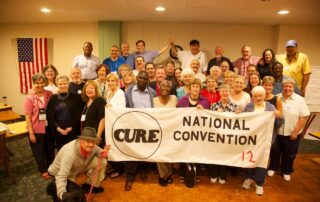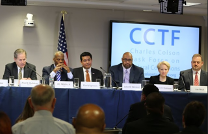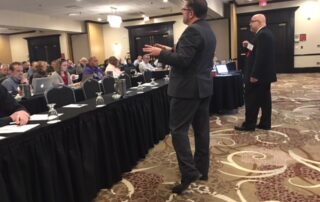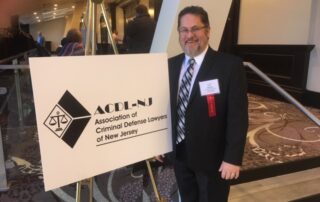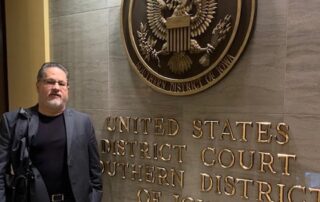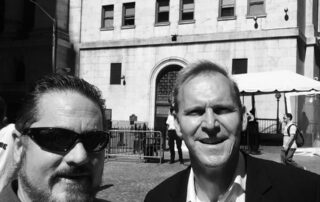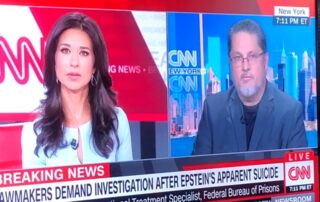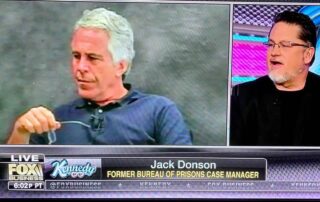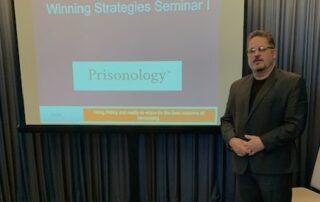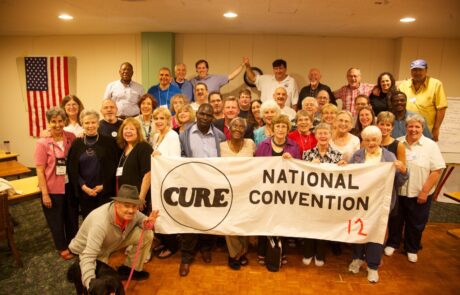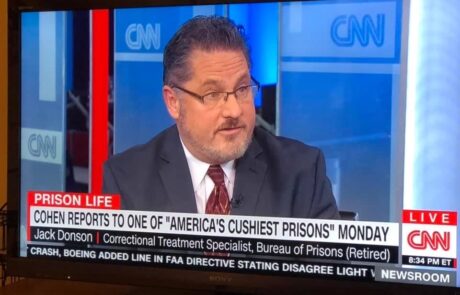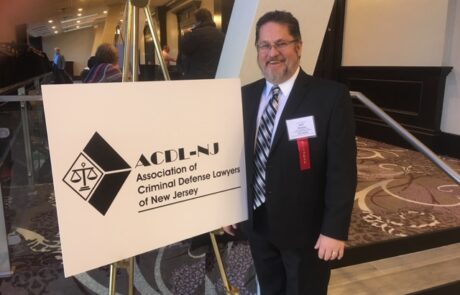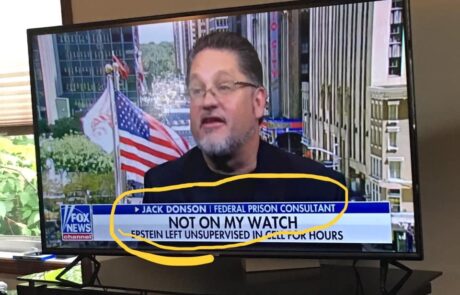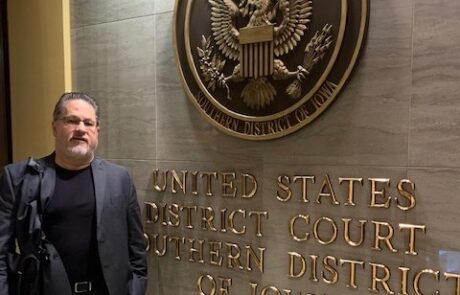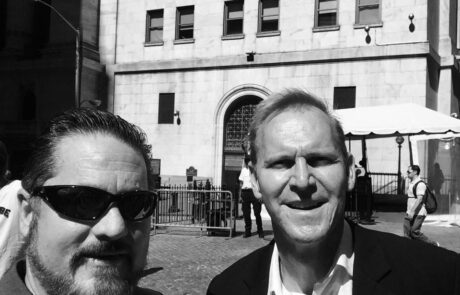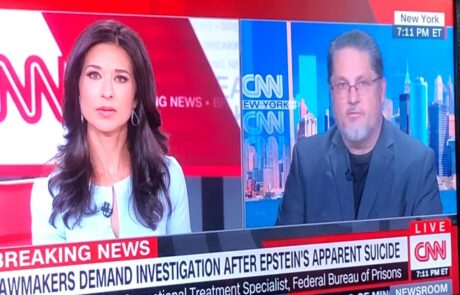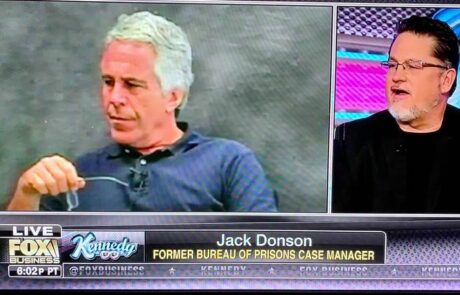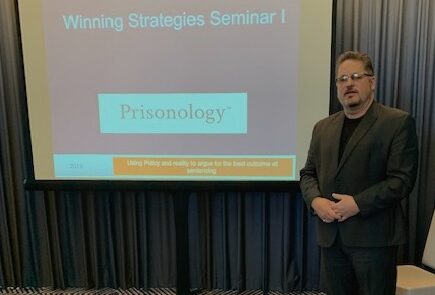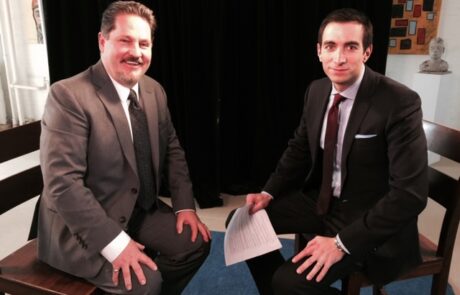The federal legislative and NGO worlds are void of people with working experience in the trenches versed in case management expertise, working prison experiences and policy application.
Legislators and Government Officials have a limited understanding of how crime legislation impacts Federal prison populations. A field perspective lends credibility and fosters effective legislation for intended outcomes. Since my retirement, I have been participating in reform efforts with stake holders in Washington DC. I have testified on Capitol Hill to the Colson Commission Task Force on Federal Corrections where I articulated practical reforms that could be implemented immediately under the existing statutory framework.
I also provided input to and attended the meeting for the “Solitary” study with stake holders which was conducted by CNA under a contract from the National Institute of Corrections. While visiting with politicians, staffers, academics and NGO groups on both sides of Capital Hill, it was clear feedback is needed from a technical field perspective. I am suspicious and not impressed with the DC reform world and have come to coin the term “The NGO Mafia”. 😉
In my humble and independent perspective, there is a lot of exploitation in the name of reform and it has become big business. Philanthropists, the public and governments in general are exploited for their resources which could be spent more on direct programs and services rather than Think Tanks, positons, rent, blue ribbon commissions, etc. Let’s face it, very little reform has been accomplished in decades and the recent efforts are extremely flawed when it comes to “back-end” prison reforms. While I applaud the front end measures of the First Step Act, there are many problems with this legislation from discriminatory PATTERN risk assessments, to the lack of field current, applicable transparency and field experience of the “Independent Review Committee”. Many, if not all of the back end prison incentives disproportionately favor white collar people and include false promises.
Another prime example of this was the Second Chance Act (SCA).
Although this legislation created grants to assist in Re-entry efforts, it fell short in other areas. In this legislation, there was a provision for a program called “The Elderly Offender Pilot Program (EOP) “. The drafting of this legislation was short sighted as the program criteria only qualified just over 100 inmates nationally. I subsequently met with congressional staff of Senator Leahy for improvements to the ELP regarding the Re-Authorization of the SCA. It was promising to see some of these revisions in the FSA that reduced the age requirement to 60 and time needed to be served to 66%. A continued problem with the continuance of the EOP is no different than it was under the SCA.
While working for the BOP, I referred one of the first EOP offenders in the country to the Washington, DC Central office but they were denied program participation because of past violence from over 30 years earlier. The bureaucrats deemed this offender dangerous to the community, yet he had been incarcerated in a camp setting (without a fence), was a model inmate with an outstanding work ethic who even participated in unescorted medical furloughs in the community. Shortly after the denial, I placed one of the first offenders in the country into this program. If written properly, the EOP could have benefited thousands vs the handful who were approved early release. These shortcoming have continues under the First Step Act.
Both laws also fall short in regards to RRC (Halfway House) placement. Even though the statutory Residential Re-entry (RRC aka halfway house) placement term increased to one year under the SCA, the BOP has never utilized this law to its potential and has not built up the RRC infrastructure commensurate with population reduction initiatives. Federal Prison Camp inmates are actually being discriminated against in this regard by reduced placements. In addition, there is a great need to influence new legislation which will allow minimum and low risk people to return to society sooner and give back to the community as part of the Restorative Justice process.
There are several ways lobby groups and NGO’s can effectuate positive change in the dysfunctional prison industrial complex while actually saving tax payer dollars. Many of these ideas and concepts will be discussed in my book. Most of the changes can be accomplished under existing Federal law.
If you are advocating Federal crime legislation for a particular group or purpose, I can provide your organization the insight needed to enact meaningful laws which will have a positive outcome on the desired goals.
Not for Profits & (501C3’s)
I assist organizations who are attempting to change archaic correctional practices. In my role as Executive Director of Out4Good, I developed an initiative entitled “Correction Corrections in America“. Our long term projects included the development of an Ombudsman program, our “Out with a Job” program and my passion to develop the prototype of a multi-faceted “Comprehensive Treatment Center”. The “CTC” will include diversionary drug, mental health and veteran’s courts plus serve re-entry and low and medium level populations within urban areas. It can be a public/private pilot and will develop partnerships with universities for research and internships and community organizations to give and receive services and mentoring in the true spirit of Restorative Justice.
I made a commitment many years ago, that upon retirement, I would advocate for the incarcerated because of prison programs which are inadequate and do an extremely poor job at preparing individuals for re-entry. This deficit is not a financial resource issue. The Bureau of Prisons has an adequate budget but chooses to spend much of it on a bureaucracy of administrators at the expense of the people working in the trenches of the system. Our nation is warehousing people in dormitories and double, sometimes triple cells designed for single cell occupancy and we wonder why our recidivism rates are extremely high.
I find it financially irresponsible the Federal Bureau of Prisons, with an offender population roughly the size of the State of California’s prison population, (less than 170,000 people) has 6 Regional Offices and a Central Office with 12 divisions. This does not even take into account the Designation and Computation Center in Grand Prairie, TX and the various training centers around the country. A more staggering number is relative to administrative staffing. There are close to four thousand administrative staff, (many earning 6 figures) in the Regional and Central Offices alone. These administrative staff work in an administrative environment far removed from a prison setting.
I am opposed to the private prison industrial complex because they are spending millions of dollars lobbying for the status quo regarding legislative changes. They are a cancer to our correctional system and legislative reform efforts and have metastasized into various peripheral services allowing the governments to share in the exploitation of marginalized people.
The federal legislative and NGO worlds are void of people with working experience in the trenches versed in case management expertise, working prison experiences and policy application.
Legislators and Government Officials have a limited understanding of how crime legislation impacts Federal prison populations. A field perspective lends credibility and fosters effective legislation for intended outcomes. Since my retirement, I have been participating in reform efforts with stake holders in Washington DC. I have testified on Capitol Hill to the Colson Commission Task Force on Federal Corrections where I articulated practical reforms that could be implemented immediately under the existing statutory framework.
I also provided input to and attended the meeting for the “Solitary” study with stake holders which was conducted by CNA under a contract from the National Institute of Corrections. While visiting with politicians, staffers, academics and NGO groups on both sides of Capital Hill, it was clear feedback is needed from a technical field perspective. I am suspicious and not impressed with the DC reform world and have come to coin the term “The NGO Mafia”. 😉
In my humble and independent perspective, there is a lot of exploitation in the name of reform and it has become big business. Philanthropists, the public and governments in general are exploited for their resources which could be spent more on direct programs and services rather than Think Tanks, positons, rent, blue ribbon commissions, etc. Let’s face it, very little reform has been accomplished in decades and the recent efforts are extremely flawed when it comes to “back-end” prison reforms. While I applaud the front end measures of the First Step Act, there are many problems with this legislation from discriminatory PATTERN risk assessments, to the lack of field current, applicable transparency and field experience of the “Independent Review Committee”. Many, if not all of the back end prison incentives disproportionately favor white collar people and include false promises.
Another prime example of this was the Second Chance Act (SCA).
Although this legislation created grants to assist in Re-entry efforts, it fell short in other areas. In this legislation, there was a provision for a program called “The Elderly Offender Pilot Program (EOP) “. The drafting of this legislation was short sighted as the program criteria only qualified just over 100 inmates nationally. I subsequently met with congressional staff of Senator Leahy for improvements to the ELP regarding the Re-Authorization of the SCA. It was promising to see some of these revisions in the FSA that reduced the age requirement to 60 and time needed to be served to 66%. A continued problem with the continuance of the EOP is no different than it was under the SCA.
While working for the BOP, I referred one of the first EOP offenders in the country to the Washington, DC Central office but they were denied program participation because of past violence from over 30 years earlier. The bureaucrats deemed this offender dangerous to the community, yet he had been incarcerated in a camp setting (without a fence), was a model inmate with an outstanding work ethic who even participated in unescorted medical furloughs in the community. Shortly after the denial, I placed one of the first offenders in the country into this program. If written properly, the EOP could have benefited thousands vs the handful who were approved early release. These shortcoming have continues under the First Step Act.
Both laws also fall short in regards to RRC (Halfway House) placement. Even though the statutory Residential Re-entry (RRC aka halfway house) placement term increased to one year under the SCA, the BOP has never utilized this law to its potential and has not built up the RRC infrastructure commensurate with population reduction initiatives. Federal Prison Camp inmates are actually being discriminated against in this regard by reduced placements. In addition, there is a great need to influence new legislation which will allow minimum and low risk people to return to society sooner and give back to the community as part of the Restorative Justice process.
There are several ways lobby groups and NGO’s can effectuate positive change in the dysfunctional prison industrial complex while actually saving tax payer dollars. Many of these ideas and concepts will be discussed in my book. Most of the changes can be accomplished under existing Federal law.
If you are advocating Federal crime legislation for a particular group or purpose, I can provide your organization the insight needed to enact meaningful laws which will have a positive outcome on the desired goals.
Not for Profits & (501C3’s)
I assist organizations who are attempting to change archaic correctional practices. In my role as Executive Director of Out4Good, I developed an initiative entitled “Correction Corrections in America“. Our long term projects included the development of an Ombudsman program, our “Out with a Job” program and my passion to develop the prototype of a multi-faceted “Comprehensive Treatment Center”. The “CTC” will include diversionary drug, mental health and veteran’s courts plus serve re-entry and low and medium level populations within urban areas. It can be a public/private pilot and will develop partnerships with universities for research and internships and community organizations to give and receive services and mentoring in the true spirit of Restorative Justice.
I made a commitment many years ago, that upon retirement, I would advocate for the incarcerated because of prison programs which are inadequate and do an extremely poor job at preparing individuals for re-entry. This deficit is not a financial resource issue. The Bureau of Prisons has an adequate budget but chooses to spend much of it on a bureaucracy of administrators at the expense of the people working in the trenches of the system. Our nation is warehousing people in dormitories and double, sometimes triple cells designed for single cell occupancy and we wonder why our recidivism rates are extremely high.
I find it financially irresponsible the Federal Bureau of Prisons, with an offender population roughly the size of the State of California’s prison population, (less than 170,000 people) has 6 Regional Offices and a Central Office with 12 divisions. This does not even take into account the Designation and Computation Center in Grand Prairie, TX and the various training centers around the country. A more staggering number is relative to administrative staffing. There are close to four thousand administrative staff, (many earning 6 figures) in the Regional and Central Offices alone. These administrative staff work in an administrative environment far removed from a prison setting.
I am opposed to the private prison industrial complex because they are spending millions of dollars lobbying for the status quo regarding legislative changes. They are a cancer to our correctional system and legislative reform efforts and have metastasized into various peripheral services allowing the governments to share in the exploitation of marginalized people.

